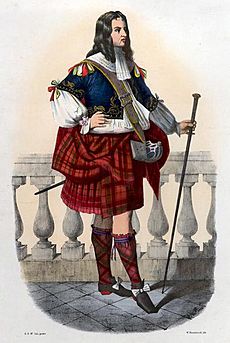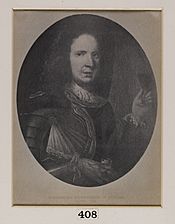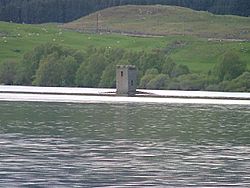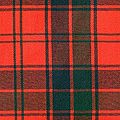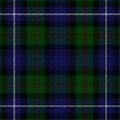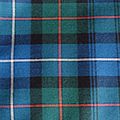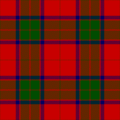Clan Robertson facts for kids
{{Infobox clan |image badge =Clan member crest badge - Clan Robertson.svg |clan name =Clan Robertson / Clan Donnachaidh / Clan Duncan |chiefs crest =Dexter hand holding up an imperial crown Proper |chiefs motto = Virtutis gloria merces (Glory is the reward of valour) |chiefs slogan = |war cry = Garg 'nuair dhùisgear (Fierce when roused) |region = Highlands |district =Struan, Perthshire |origins = |gaelic names =Clann Donnchaidh |image arms = Robertson of Struan Arms.svg |plant badge =bracken |animal = |pipe music =Teachd Chlann Dhonnchaidh (Coming of the Robertsons) or Teachd Chlann Donnachaidh (The Clan Donnachie has arrived). |chiefs name =Gilbert Robertson of Struan |chiefs title =The 24th Chief of Clan Donnachaidh |chiefs gaelic title=Mac Dhonnchaidh |seat = |historic seat = Dunalastair Castle |septs = Collier, Colyear, Conlow
Connachie, Dobbie
Dobieson, Dobie Dobinson,Dobson
Donachie, Donica, Donnachie,Duncan, Duncanson, Dunkeson, Dunnachie, Inches, MacConachie, MacConlogue, MacConnichie, MacDonachie, MacInroy, MacIver, MacIvor, MacLagan, MacLaggan, MacRob, MacRobb, MacRobbie, MacRobert, MacRobie, MacWilliam, McConnachie, [McRobie,
The Clan Robertson, also known as Clan Donnachaidh or Clan Duncan, is a very old Scottish clan from the Highlands. Its members are believed to be related to the ancient Celtic Earls of Atholl. These earls were descendants of King Duncan I, whose name in Scottish Gaelic is Donnchadh. This connection shows the clan's deep roots in Scottish history.
Contents
The Story of Clan Robertson
Early History and Brave Beginnings
The first recognized chief of the clan was Donnchaidh Reamhar, which means "Stout Duncan". He was a landowner and a leader of a group of families near Dunkeld, in Perthshire. Stout Duncan was a loyal supporter of King Robert I during the Wars of Scottish Independence. It's said he even helped King Robert after a battle in 1306.
Supporting Robert the Bruce
The clan believes that Stout Duncan's family and followers helped Robert the Bruce at the famous Battle of Bannockburn in 1314. After this, his descendants became known as the Duncansons, or in Gaelic, Clann Dhònnchaidh, meaning "Children of Duncan". Stout Duncan is thought to have died in battle. His son, Robert, then became the chief. The clan later took the name Robertson from him.
Clan Conflicts and Royal Rewards
In 1394, the clan, then called Clandonoquhy, had a fight with Clan Lindsay and Clan Ogilvy during a cattle raid. Sir Walter Ogilvy was killed in this battle. The clan had a reputation for raiding and feuding in medieval Scotland. However, their chiefs always stayed loyal to the Scottish kings, especially the Bruce and Stewart families.
Capturing the King's Killers
Robert Riabhach ("Grizzled") Duncanson was the 4th Chief of the clan. He was a strong supporter of King James I. When the king was murdered in Perth, Robert Riabhach tracked down two of the killers, Sir Robert Graham and the King's uncle, Walter Stewart. He captured them and handed them over to the Crown. They were severely punished in Edinburgh.
As a reward for capturing the assassins, King James II gave the 4th chief a special crest badge in 1451. This badge shows a right hand holding up a royal crown. The clan's coat of arms also has a unique supporter: a "savage man in chains". This represents the capture of Graham. Because of Robert Riabhach and his brave actions, his descendants took the name Robertson. King James II also made the clan's lands into the Barony of Struan. These lands were once very large in the Highlands.
Robert Riabhach died in 1460 from battle wounds. His son, Alexander, became the next chief. The Clan Robertson then had a feud with the Clan Stewart of Atholl. William Robertson, the sixth chief, was killed trying to get back lands taken by the Stewarts. The eighth chief was also murdered, and his brother took over.
Many of the clan's chiefs were buried at Struan parish church. This church is very old, dating back to early Christian times. The first chief, Donnchadh Reamhar, is said to be buried in the church of Dull. More recent chiefs have been buried in a family vault at Dunalastair.
Times of War and Change
The Scottish Civil War
Under Alexander Robertson, the 12th chief, the clan supported Montrose in all his battles during the Scottish Civil War. During this time, the main Robertson castle at Invervack was burned by Cromwell's forces. Many important family records were lost. The Clan Robertson fought bravely at the Battle of Inverlochy (1645), helping the king's side win. Alexander Robertson of Lude also fought for King Charles I. In return, Cromwell's forces burned Lude.
In 1653, the Earl of Glencairn came to Rannoch to find support for Charles II. He gathered the Clan MacGregor and Alexander Robertson led his own men. They met and marched towards Loch Garry. However, the clan leaders argued a lot. This made it easy for Cromwell's General, George Monk, to win the Battle of Dalnaspidal.
Jacobite Risings
Alexander Robertson, the 13th chief, was born in 1668. He joined the Jacobite rising of 1689. He was captured after the Jacobite defeat at the Battle of Dunkeld. After being set free, he lived in France for thirteen years and served in the French army. He came back to Scotland in 1703.
In 1715, Alexander Robertson, the 13th chief, led 500 men of Clan Robertson to support the Earl of Mar at the Battle of Sheriffmuir. He was captured again but was rescued and went back to France. In 1724, it was estimated that the clan could gather 800 fighting men. By 1745, this number was about 700.
After the Jacobite rising of 1745 was defeated, the Robertson lands were taken by the government. However, most of them were given back to the chief, another Alexander Robertson, in 1784. This happened after the Highlands became peaceful.
Later, in the 1800s, some people were moved from their homes on Robertson clan land during a time called the Highland Clearances. This happened in places like Strathcarron.
Today, only the family vault at Dunalastair is still owned by the chief's family. However, the title Baron of Struan is still passed down through the family.
Clan Castles and Homes
- Dunalastair Castle was the first main home of the Clan Robertson chiefs. Later, a new house called Dall House was built there.
- Lude Castle belonged to the Clan Robertson from at least the 1600s. It was burned by Oliver Cromwell's forces in 1650 because Alexander Robertson of Lude had fought for the king.
- Auchleeks Castle was held by the Clan Robertson from the 1530s. A mansion was later built on the site. The family sold the property in 1962.
- Eilean nam Faoilaig, near Kinloch Rannoch, is an island with the remains of a castle. The Robertsons of Struan used it as a safe place and sometimes as a prison.
Clan Symbols and Traditions
Clan Motto and Crest
The clan's motto is Virtutis gloria merces, which means 'Glory is the reward of valour'. Their war cry is Garg 'nuair dhùisgear, meaning 'Fierce when Roused'. The clan's crest shows a hand holding up a royal crown.
Clan Music and Badges
The clan's plant badge is the bracken. This plant grows a lot around Loch Rannoch, where the clan had lands. The clan also has special pipe music, including:
- Salute: Fàilte Thighearna Sruthain (Struan Robertson's Salute)
- Gathering: Thàinig Clann Dhònnchaidh (The Robertsons Are Come)
- March: Till an Crodh Dhònnchadh (Turn the Cattle, Dònnchadh); Riobain Gorm (Blue Ribbon); Teachd Chlann Dhònnchaidh (Coming of the Robertsons)
- Lament: Cumha Sruthain (Lament for Robertson of Struan)
The current chief of Clan Robertson is Alexander Gilbert Haldane Robertson of Struan. He is the 24th Chief of Clan Robertson.
Clan Names and Families
Different Clan Names
The main surname used by the clan is Robertson. However, there are many other names connected to the clan. Some common Gaelic names include:
- MacDhònnchaidh (meaning 'son of Duncan')
- MacRaibeirt (meaning 'son of Robert')
- Robasdan (used after a first name)
- An Robasdanach (used on its own, meaning 'the Robertson')
- Clann MhicDhònnchaidh / Clann 'IcDhònnchaidh (meaning 'Clan Robertson')
- Clann Dhònnchaidh (another collective name)
- Na Robasdanaich (meaning 'the Robertsons as a whole')
Clan Branches and Septs
The clan has several important branches, which are different family lines within the clan. These include:
- Robertson of Auchleeks
- Robertson of Faskally
- Robertson of Inches
- Robertson of Kindeace
- Robertson of Kinlochmouidart
- Robertson of Lude
- Robertson of Struan
Many other surnames are also linked to the Clan Robertson. These are called "septs" and often come from different spellings or translations of the original clan names. Some of these septs include:
- Barr
- Collier
- Colyear
- Conlow
- Connachie
- Dobbie
- Dobieson
- Dobinson
- Dobson
- Donachie
- Donnachie
- Donica
- Duncan
- Duncanson
- Dunkeson
- Dunnachie
- Dunshea
- Green
- Inches
- MacConachie
- MacConnachie
- MacConlogue
- MacConnichie
- MacDonachie
- MacGlashan
- MacInroy
- MacIver
- MacIvor
- MacLagan
- MacLaggan
- MacRob
- MacRobb
- MacRobbie
- MacRobert
- MacRobie
- MacWilliam
- McDonnough
- McConnachie
- McConnico
- McConochie
- McInroy
- McRobie
- Reed
- Reid
- Robb
- Robbie
- Roberts
- Robison
- Robinson
- Roberson
- Robson
- Roy
- Stark
- Tannoch
- Tannochy
- Hart
Many of these names are just English versions of the Gaelic MacDhònnchaidh, or direct translations like Duncan and Duncanson.
Images for kids
-
Robertson red tartan


